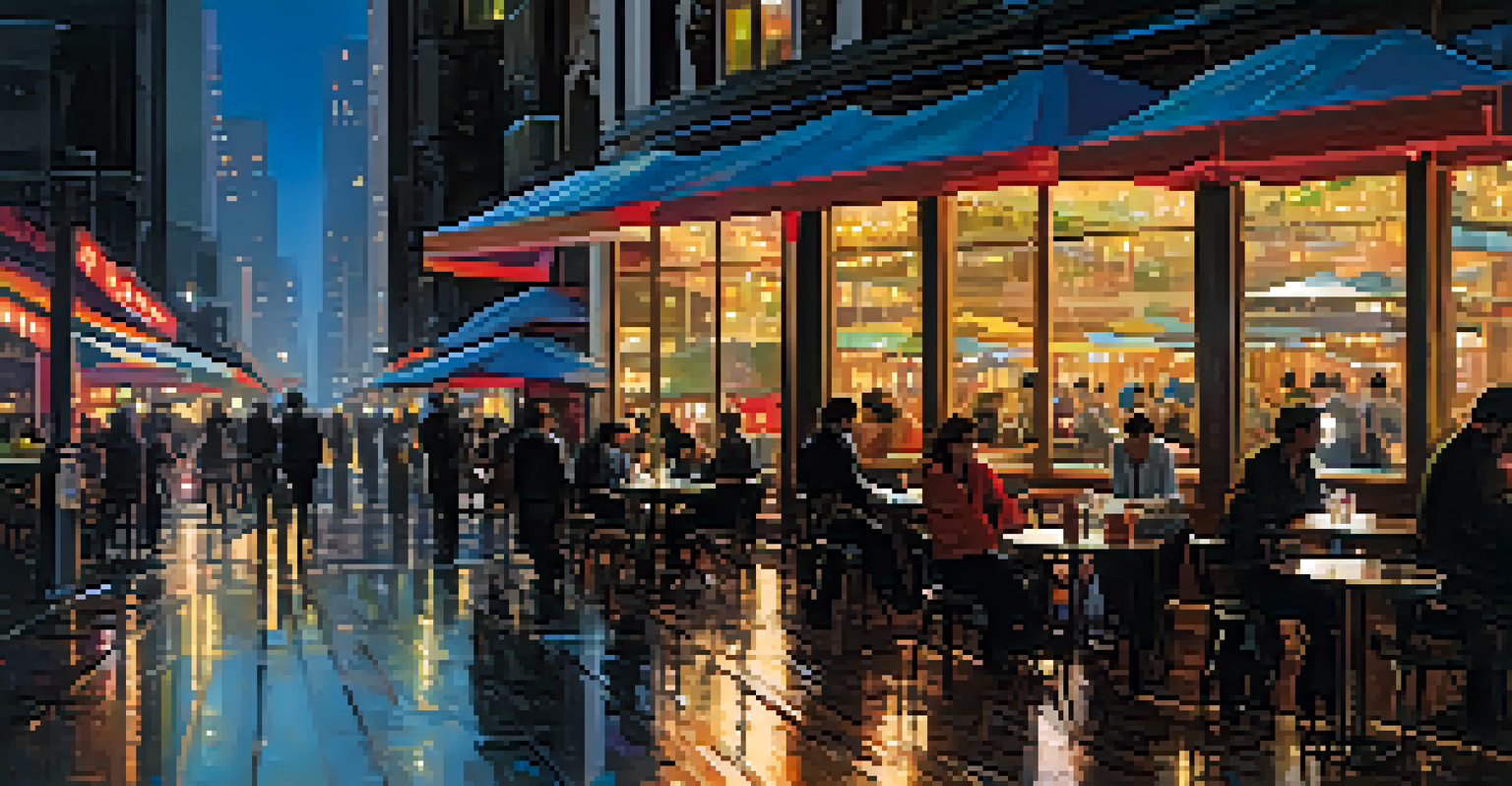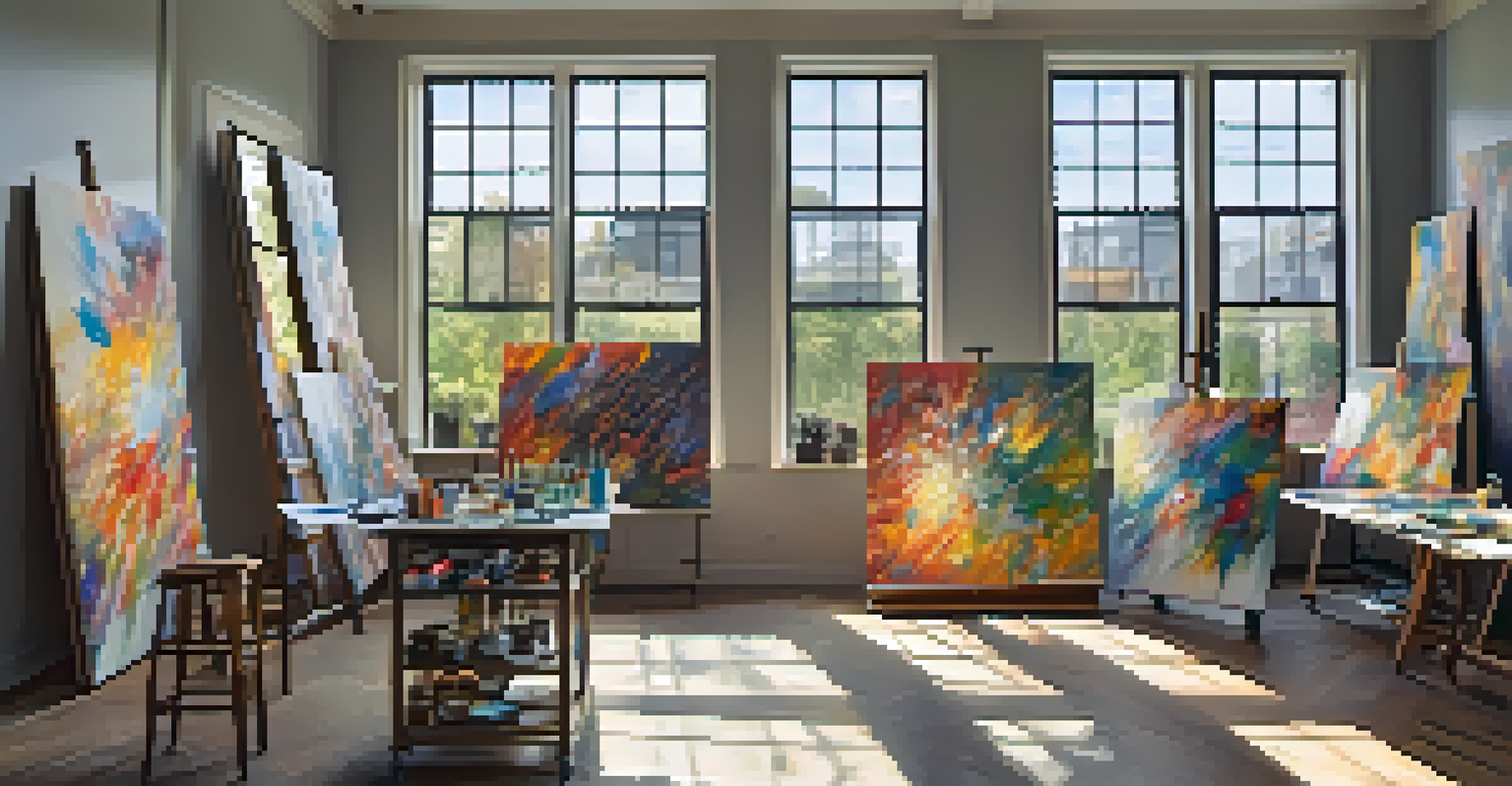The Impact of Scale and Proportion in Painting Composition

Understanding Scale in Painting Composition
Scale refers to the size of an object in relation to other objects within a painting. It helps establish a sense of space and depth, guiding the viewer's eye through the artwork. For instance, a large tree in the foreground can create a feeling of intimacy, while a distant mountain may give a sense of vastness.
The human figure is the most important subject in painting. It is the measure of everything else.
When artists manipulate scale, they can evoke different emotions. A small figure against a sprawling landscape can convey feelings of loneliness or insignificance, while larger figures can evoke strength or heroism. This dynamic is crucial in storytelling through visual art.
In essence, understanding scale allows artists to control how viewers perceive their work. By thoughtfully considering the size of elements in relation to one another, they can create a more engaging and impactful composition.
The Role of Proportion in Artistic Expression
Proportion deals with the relationship between the sizes of different elements in a painting. It’s about balance and harmony—how one part relates to another in size and scale. Think of it as a recipe: too much of one ingredient can throw off the entire dish.

In art, proportion is vital for creating realistic representations. For example, the human figure has specific proportions that, when adhered to, create a lifelike image. Deviating from these proportions can either enhance a piece stylistically or lead to a distorted representation that feels off.
Scale Shapes Emotional Responses
Manipulating scale in art can evoke various emotions, such as loneliness or strength, significantly impacting the viewer's experience.
Artists often play with proportion to create stylized effects or to emphasize certain features. By exaggerating or minimizing proportions, they can direct the viewer's focus, making specific elements stand out and enhancing the overall narrative.
Historical Context: Scale and Proportion in Art
Throughout art history, the concepts of scale and proportion have evolved significantly. In the Renaissance, artists like Leonardo da Vinci employed mathematical ratios to achieve harmony in their compositions. This focus on proportion gave rise to the idealized forms that we associate with classical beauty.
Art is the most beautiful of all lies; it is the most beautiful of all truths.
In contrast, movements like Cubism challenged traditional notions of proportion, deconstructing objects into geometric shapes and varying scales. This shift allowed artists to explore new perspectives and dimensions, changing how we view reality in art.
Understanding these historical shifts helps us appreciate the ongoing dialogue between artists and the principles of scale and proportion. Each movement reflects the changing perceptions of beauty, reality, and the human experience.
Psychological Effects of Scale and Proportion
Scale and proportion have profound psychological effects on viewers. Larger elements can dominate a composition, instilling feelings of awe or power. Conversely, smaller elements can evoke curiosity or a sense of intimacy, drawing viewers in for a closer look.
For example, consider a large, imposing painting of a cityscape. The scale can make viewers feel overwhelmed by the urban environment, while a small, detailed painting of a cozy café might evoke warmth and nostalgia. These emotional responses are key to how we engage with art.
Proportion Ensures Visual Harmony
Understanding proportion is essential for achieving balance and realism in art, allowing artists to effectively direct the viewer's focus.
Artists are acutely aware of these psychological impacts, using them to enhance their narratives. By carefully considering scale and proportion, they can evoke specific feelings, guiding the viewer’s emotional journey through the artwork.
Practical Tips for Using Scale and Proportion
When creating your own artwork, start by experimenting with scale. Try creating a small sketch of a large subject to see how it changes your perception. This exercise can help you understand how size influences the viewer's experience.
Next, pay attention to proportion. Use reference images to study the relationships between different elements. Whether you’re painting a landscape or a portrait, understanding these relationships can improve the realism and effectiveness of your work.
Lastly, don’t be afraid to break the rules! While understanding scale and proportion is essential, art is also about expression. Experimenting with non-traditional proportions can lead to unique and compelling compositions that stand out.
The Influence of Scale and Proportion on Composition
Composition is the arrangement of visual elements within a painting, and scale and proportion are critical in achieving a cohesive look. A well-balanced composition considers how different elements relate to one another, creating visual harmony.
For instance, using a large object to anchor a composition can create stability, while smaller elements can add dynamism. This interplay helps lead the viewer's eye through the painting, creating a sense of movement and flow.
Historical Shifts in Art Principles
The evolution of scale and proportion throughout art history reflects changing perceptions of beauty and reality, influencing modern artistic expression.
Ultimately, the thoughtful use of scale and proportion can transform a flat canvas into a vibrant, engaging experience. It allows artists to create depth, balance, and dynamism, inviting viewers into their artistic world.
Conclusion: The Art of Scale and Proportion
In conclusion, scale and proportion are powerful tools in the artist's toolkit. They not only influence the aesthetic appeal of a painting but also the emotional response it elicits from viewers. By mastering these concepts, artists can enhance their storytelling and artistic expression.
As we’ve seen, the impact of scale and proportion has evolved through history, shaping the way we understand and appreciate art. Whether sticking to traditional methods or venturing into modern interpretations, these principles remain crucial.

So, whether you’re an aspiring artist or simply an art lover, understanding the significance of scale and proportion can deepen your appreciation of paintings. The next time you view a piece, consider how these elements contribute to its overall impact.